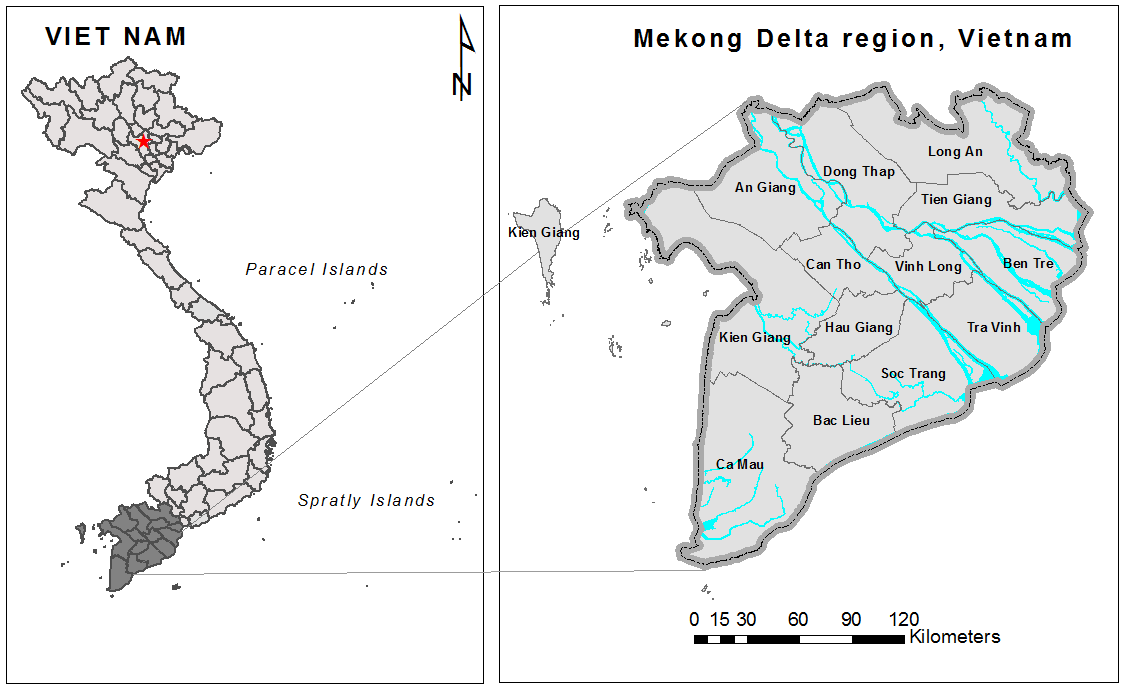Vietnam is located between 9 and 23 degrees north. Eastern Vietnam has a long coastline on the Gulf of Tonkin and the South China Sea. It has a tropical monsoon type of climate; from May-Sep the south monsoon sets in, and the country is dominated by south to southeasterly winds. From Oct-April, the north monsoon is dominant with northerly to northeasterly winds affecting the country. There is a transition period between each monsoon season when winds are light and variable.
The country is mountainous in the northwest and in the central highlands facing the South China Sea, with peaks reaching up to 8000ft (2450m) In the north around Hanoi, and in the south around Ho Chi Minh City, there are extensive low-lying regions in the Red River delta and the Mekong delta respectively.
Vietnam has a single rainy season during the south monsoon (May-Sep). Rainfall is infrequent and light during the remainder of the year. Rainfall is abundant, with annual rainfall exceeding 1000mm almost everywhere. Annual rainfall is even higher in the hills, especially those facing the sea, in the range of 2000-2500mm.
For coastal areas and the parts of the central highlands facing northeast, the season of maximum rainfall is during the south monsoon, from Sep-Jan. These regions receive torrential rain from typhoons that move in from the South China Sea at this time of the year. The weather at this time is cloudy with frequent drizzles.
During the north monsoon, northern Vietnam has cloudy days with occasional light rain, while southern Vietnam tends to be dry and sunny.
Temperatures are high all year round for southern and central Vietnam, but northern Vietnam has a definite cooler season as the north monsoon occasionally advects cold air in from China. Frost and some snow may occur on the highest mountains in the north for a few days a year. In southern Vietnam, the lowlands are sheltered from outbreaks of colder northerly air and the dry season is warm to hot with much sunshine.
Best Time to Visit Mekong Delta in Vietnam
More than perhaps any other destination in Vietnam, the Mekong Delta is heavily affected by the weather because boating is the main form of transportation there. The best time to travel to the region is between November and January when it is cool and the water level is at its highest.
The Weather in the Mekong Delta
Boats are the primary means of transportation in the Mekong Delta so traveling during a season when the water level is high and the temperature is cool is highly recommended.
There are two main seasons in the Mekong Delta: a rainy season and a dry season. The temperature in both seasons is generally comfortable, although some months (November to January) are considered more comfortable for traveling.
Dry Season: December to April
From December to the end of April, Vietnam gets a break from all the rain. During this season, while occasional rains still occur, you can expect clearer blue skies, brilliant green landscapes, and lower levels of humidity.
The average temperature from December to February in the Mekong Delta ranges from about 22ºC at night to about 32ºC in the daytime.
It starts to get hot in March with a temperature of about 34ºC in the daytime and it reaches its highest temperatures in April and May (about 35–38ºC in the daytime).
This season is excellent for outdoor activities such as cycling, hiking, and experiencing the local culture. On nice days local musicians will often sit outside and play their instruments. If you are feeling adventurous you can try walking between the villages or simply take a relaxing boat ride in the shade of the trees.
Rainy Season: May to November
The rainy season begins in May and continues through most of November. While rainy, this is also the hottest time of the year and the humidity is often uncomfortably high. The heaviest rainfall occurs in June and July.
This period is considered to be the low season for traveling in the Mekong Delta. What is the advantage of traveling in the low season?
- Summer is the best time to eat fresh fruits that have been grown locally, such as dragon fruits and mangoes. Fishing is also said to be better during these months.
- You will enjoy lower prices for tours.



